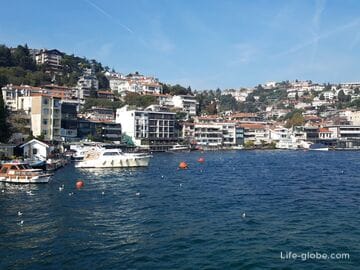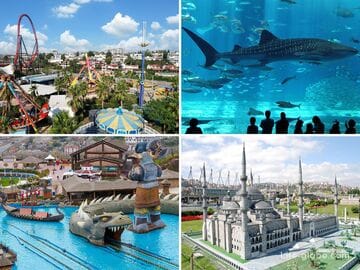This article presents a list (with photos, descriptions and addresses) of the most significant, large and beautiful mosques, cathedrals and churches in Istanbul that are worth visiting first or if not much time is allocated to the city (1-2-3 days).
If you need the most complete and detailed list of the shrines of Istanbul, then you can view it here →
You can visit mosques, churches and cathedrals of Istanbul on your own or with city tours
TOP mosques, cathedrals and churches in Istanbul
Blue Mosque (Sultanahmet Mosque)
The Blue Mosque or Sultanahmet Mosque (Sultanahmet Camii / Sultan Ahmet Camii) is a historical imperial mosque, which is the first mosque in the city, and is also considered an outstanding example of Islamic and world architecture.
The mosque is known primarily for its six minarets and interior decoration, which is considered a masterpiece.
Today it is a functioning mosque, which is included in the UNESCO World Heritage List and attracts numerous tourists.
The mosque is located in the central part of the European side of Istanbul, in Sultanahmet district, at the address: Sultan Ahmet, Atmeydanı Cd. No:7, 34122 Fatih/Istanbul, Turkey. More about the Blue Mosque...
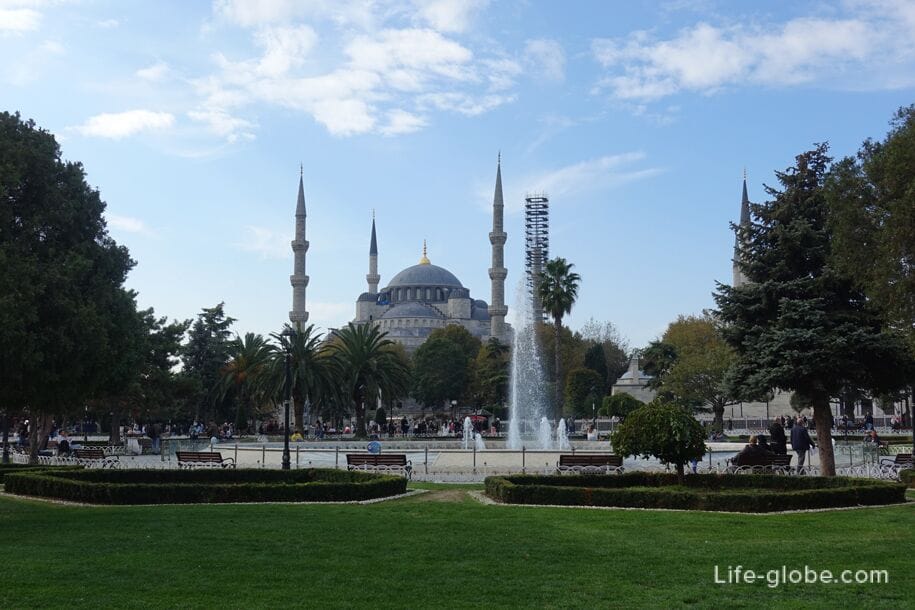
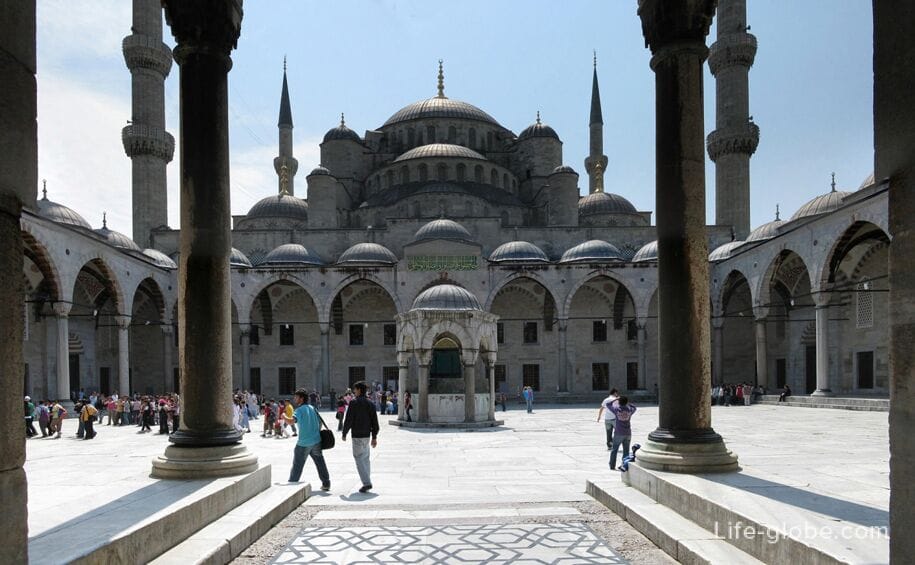
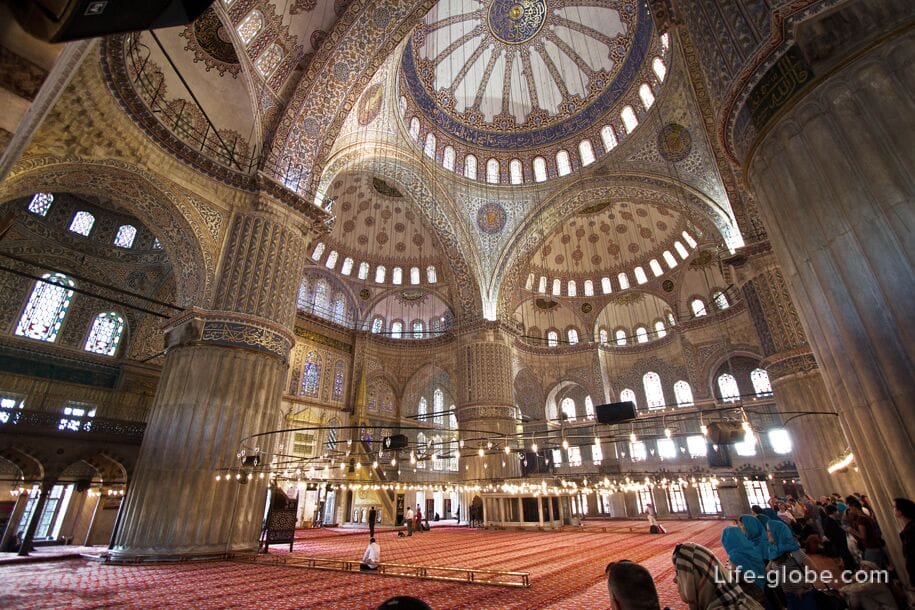
Hagia Sophia Mosque (Hagia Sophia)
Hagia Sophia or Hagia Sophia (Ayasofya) is a mosque in Istanbul, which during its history has been an Orthodox church, mosque and museum.
The mosque is one of the greatest world-famous monuments and examples of Byzantine culture, as well as a symbol of the "golden age" of Byzantium.
Hagia Sophia has mausoleums, tombs, four minarets, and the giant dome system of the mosque with arched windows is a masterpiece of architectural thought of its time.
The interior of Hagia Sophia has absorbed several cultures and religions: inscriptions in Scandinavian runes, unique Orthodox mosaics, Islamic mihrab, Sultan's lodge and minbar. The "Weeping Column" also attracts attention, which, according to legend, cures diseases and fulfills wishes.
Hagia Sophia is located near the Blue Mosque, at the address: Sultan Ahmet, Ayasofya Meydanı No:1, 34122 Fatih/Istanbul, Turkey. More about the Hagia Sophia Mosque...
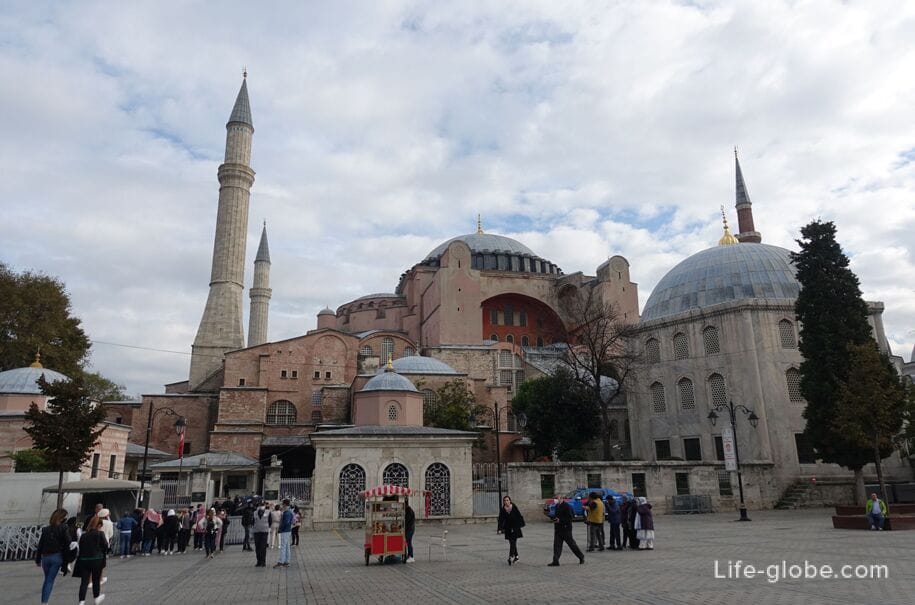

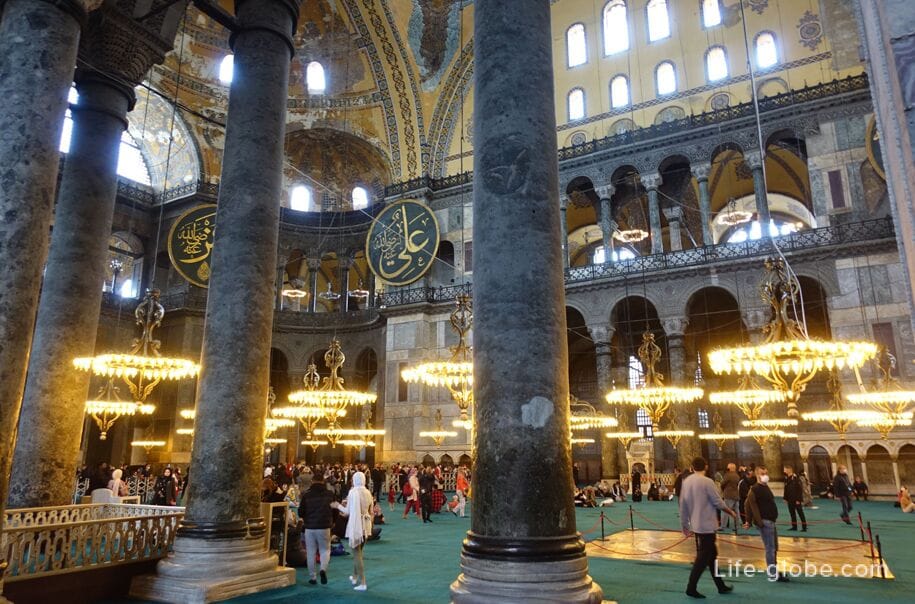
St. Irene's Church
The Church of St. Irene (Aya Irini, Aya-Irena) was built at the beginning of the 4th century on the site of the ruins of the ancient temple of Aphrodite under the Roman Emperor Constantine and was the main temple of the city before the construction of Hagia Sophia.
After the conquest of Constantinople in 1453, the church of St. Irene was not converted into a mosque and there were no significant changes in its appearance. During the 15th and 18th centuries, the church was used by the Ottomans as armories, and since 1846, it has been turned into a museum.
Entrance to the church-museum is paid.
The Church of St. Irene is located on the territory of the Topkapi Palace complex (Topkapı Sarayı). More about Topkapi Palace...
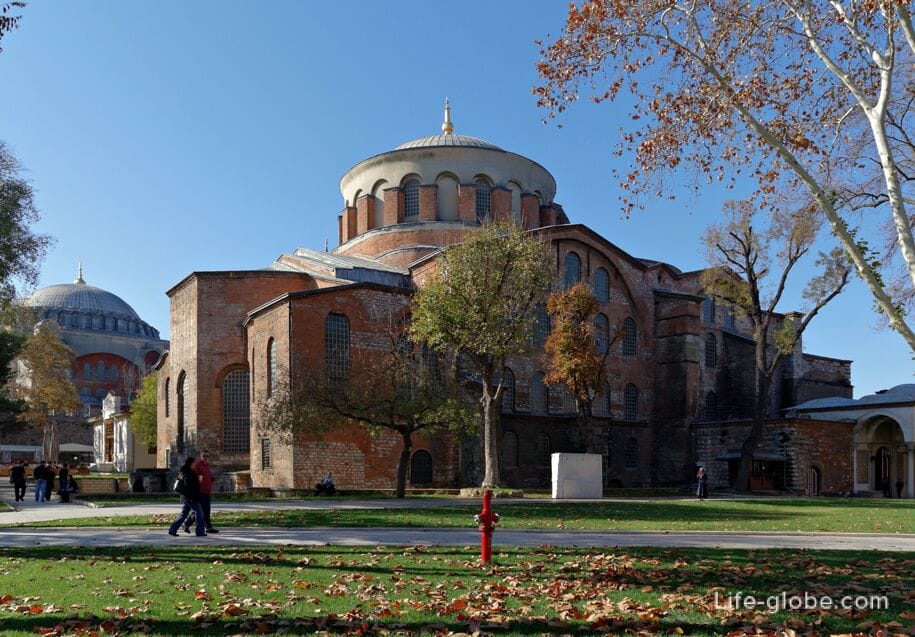
New Mosque
The new mosque (Yeni Cami, Yeni Jami) was originally called the Valide Sultan Mosque (Valide Sultan camii), and then the New Valide Sultan Mosque (Yeni Valide Sultan Camii).
The construction of the mosque as a complex was started in 1597 by order of Safiye Sultan, who was the wife of Sultan Murad III, and later Valide Sultan (Queen mother) of Sultan Mehmed III.
The appearance of this large mosque stands out against the background of the nearby buildings with 66 domes and semi-domes of pyramidal arrangement, as well as two minarets with three sherefe (balconies) on each. The mosque's windows are decorated with stained glass windows.
The mosque has a monumental courtyard (avlu), in the center of which there is a fountain for religious ablutions, but in fact the ritual of ablution is carried out from water taps near the southern wall of the mosque.
The new mosque is located in the old part of the city on the square of the same name in the Eminönü district near the Galata Bridge (Galata Köprüsü). Learn more about the Galata Bridge...



Nurosmaniye Mosque
Nuruosmaniye Mosque (Nuruosmaniye Camii) is an Ottoman mosque of 1755 with a large dome and many windows, which is notable for its architecture.
The construction of the mosque was started in 1748-1749 during the reign of Sultan Mahmud I and completed in 1755 during the reign of Sultan Osman III.
The mosque was the first in the city built in the Baroque style of Ottoman architecture, which was influenced by European models.
The dome of the mosque is the fourth largest in Istanbul, after Hagia Sophia, Suleymaniye Mosque and Fatih Mosque.
The Nurosmaniye Mosque is a complex consisting of: a mosque, a madrasah, an imaret (dining room), a turban of Osman III's mother - Valide Shehsuvar Sultan, a library of manuscripts in Ottoman, Arabic and Persian languages and a fountain located at the entrance to Kapaly Charshi.
The mosque is located near the most famous historical bazaar in Istanbul - the Grand Bazaar (Kapalı çarşı). Learn more about the Grand Bazaar...
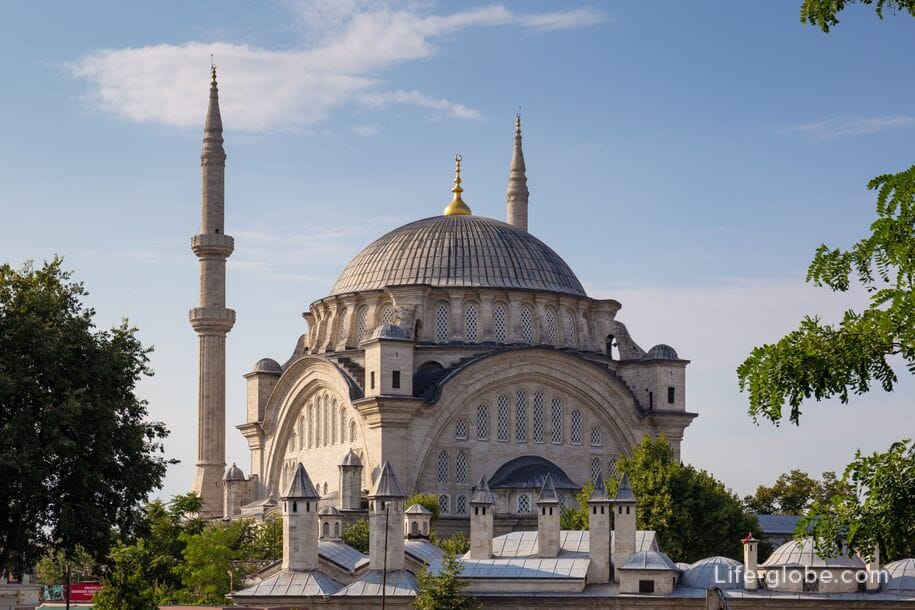

Suleymaniye
Suleymaniye (Süleymaniye Camii) is a masterpiece of architecture of the Ottoman Empire and the second most important mosque in the city after the Blue Mosque.
The mosque was built in 1551-1557 by order of Sultan Suleiman the Magnificent and was built as a complex with adjacent buildings to serve both religious and cultural needs.
Suleymaniye is a complex in which, in addition to the mosque itself with a monumental courtyard, the turbe (tombs-mausoleums) are notable, which are polygonal buildings topped with a massive dome. Inside the tombs rest: Suleiman the Magnificent, his beloved wife Hurrem (Roksolana) and their daughter Mihrimah, as well as other members of the ruler's family.
Since the mosque is located on a hill, its territory offers panoramic views of part of Istanbul and the Golden Horn Bay.
Mosque address: Süleymaniye Mah, Prof. Sıddık Sami Onar Cd. No:1, 34116 Fatih/Istanbul, Turkey. More about the Suleymaniye Mosque...
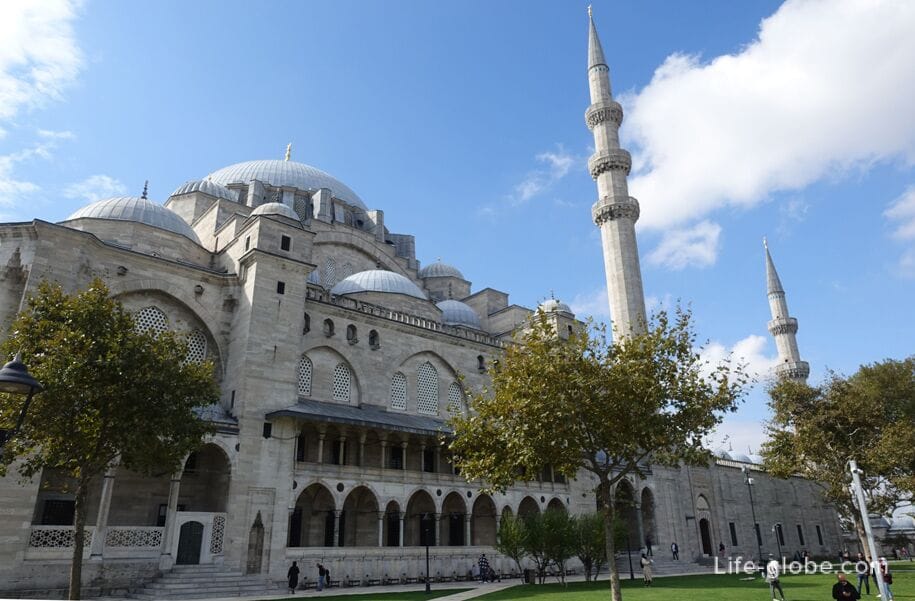
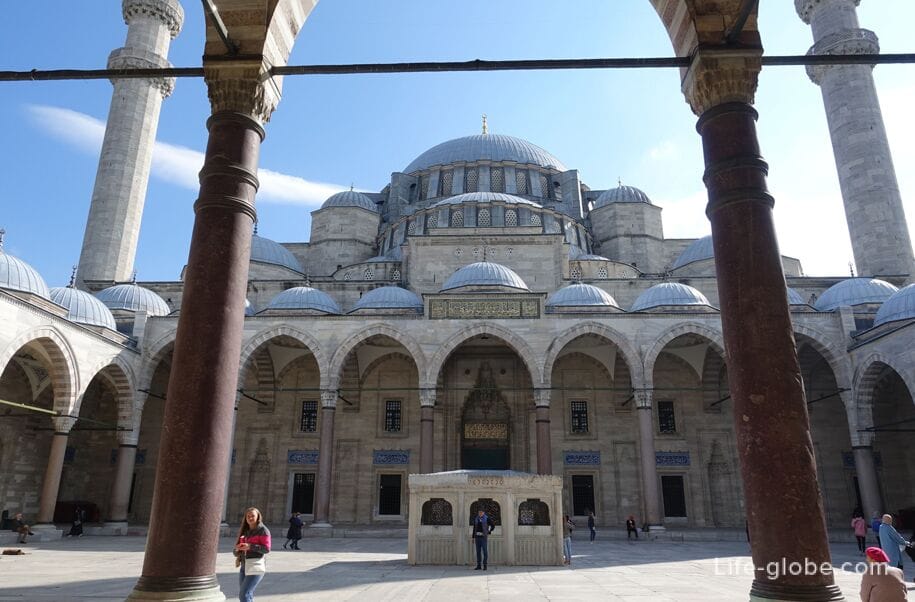
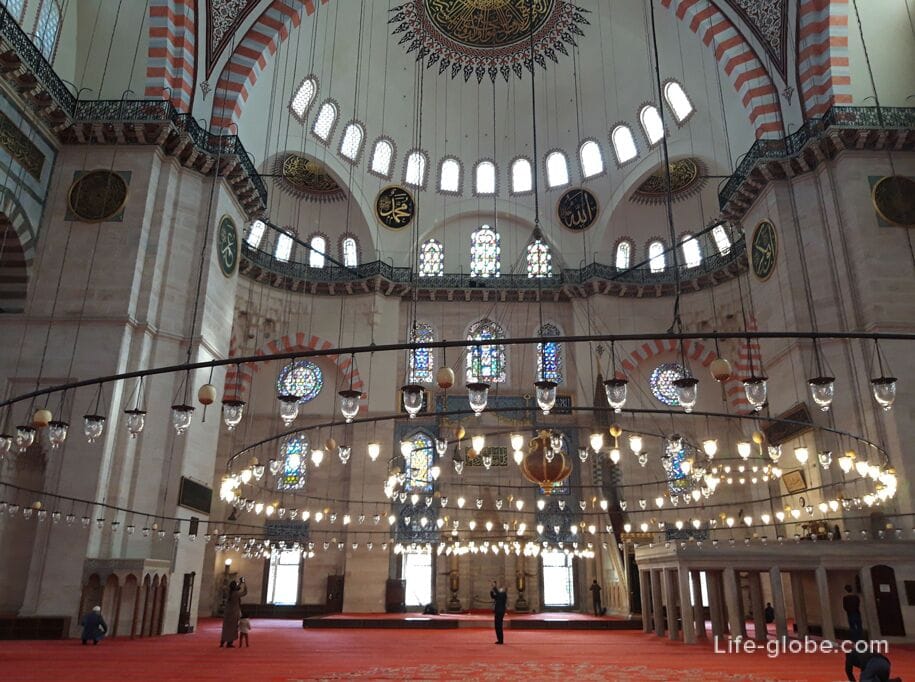
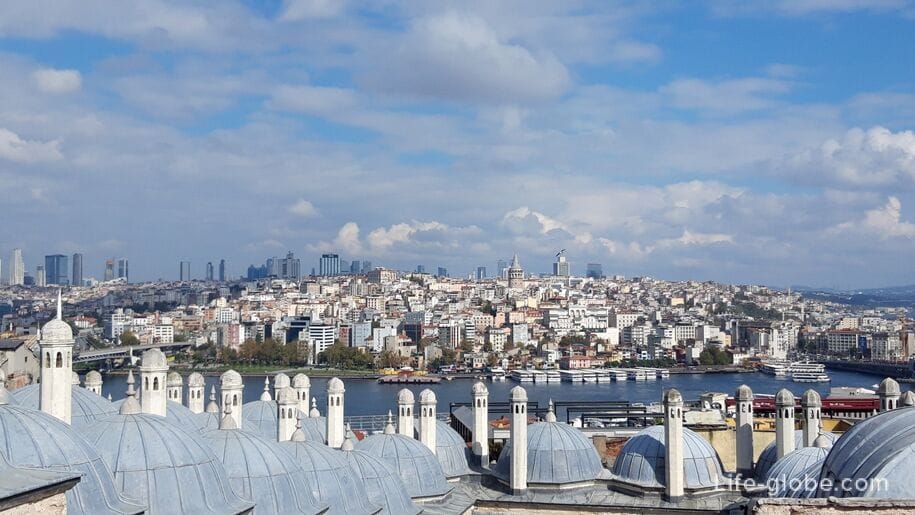
Pertevnial Valide Sultan Mosque
The Pertevniyal Valide Sultan Mosque, also known as the Aksaray Valide Mosque (Pertevniyal Valide Sultan Camii, Aksaray Valide Sultan Camii), is perhaps the most unusual mosque in Istanbul outwardly.
This Ottoman Imperial mosque was built one of the last in Istanbul during the Ottoman Empire.
The mosque was built in 1869-1871 for Pertevnial Sultan, the wife of Sultan Mahmud II and the mother of Sultan Abdul Aziz.
The mosque was designed by Sarkis Balyan as a new, at that time, architectural masterpiece.
The building is an example of Turkish Rococo with an admixture of classical Ottoman, Moorish, Turkish, Gothic, Renaissance and Empire styles. The structure of the mosque also seems to be based on Indian, North African and Andalusian architecture. The overall design of the mosque can be noted as a projection of the nascent power of the Ottoman women of that time.
The mosque has two minarets and a small (in diameter), but high dome.
The mosque consists of several different buildings. There are buildings that surround the central mosque and create a complex. These buildings consist of a tomb, a sabil, a chapel, a library and a madrasah.
The interior of the mosque, as well as its facades, is elaborately decorated and stylized with bold oriental motifs. There are classic Ottoman details on the walls: blind niches, flourishes, arabesques and floral arrangements in the Chinese style. The interior also has a simple marble mihrab and a minbar.
The grave of Sultana Pertevnial is located in the central mosque.
Mosque address: Iskenderpaşa, Atatürk Blv. No:3, 34080 Fatih/Istanbul, Turkey.
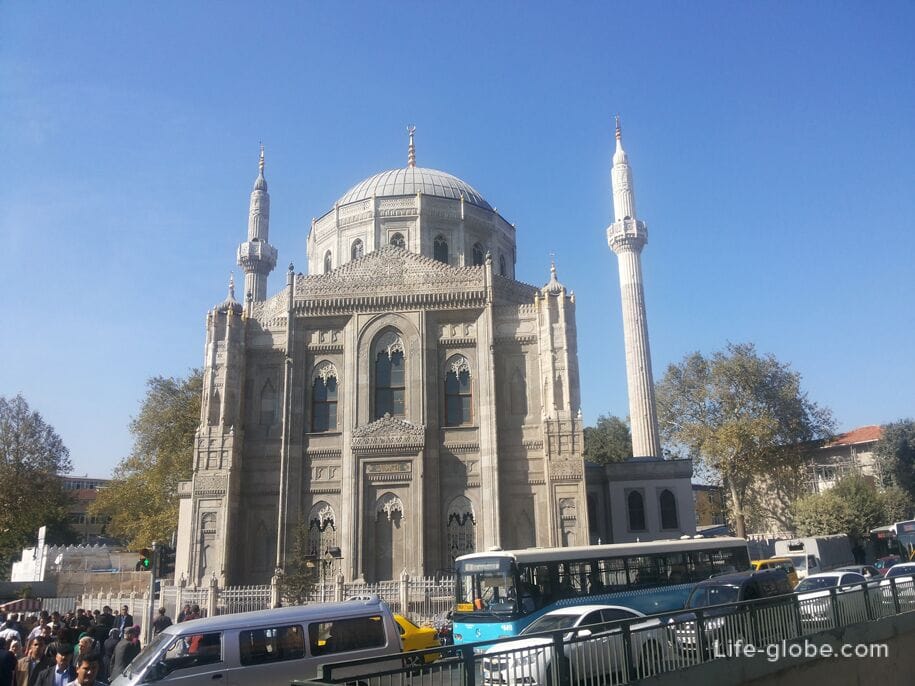
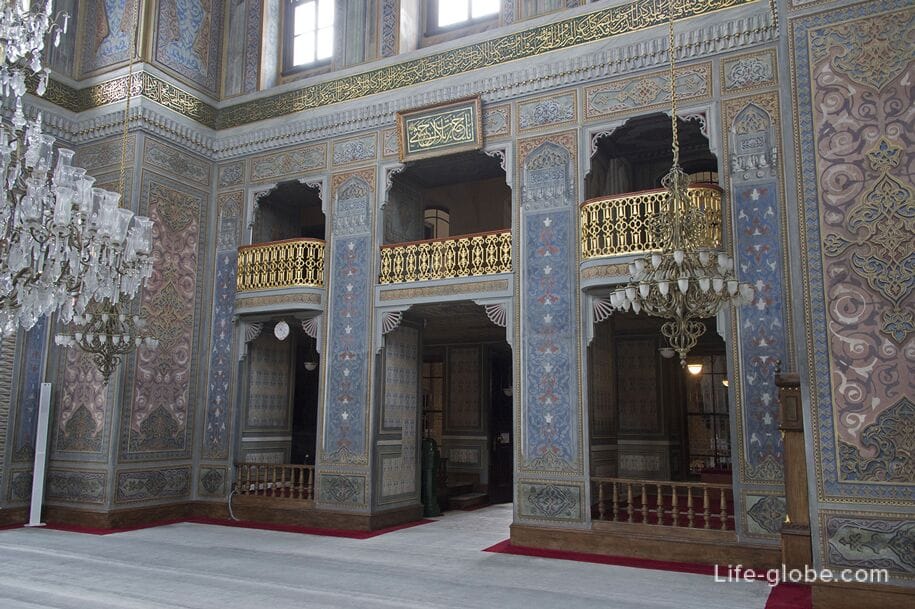
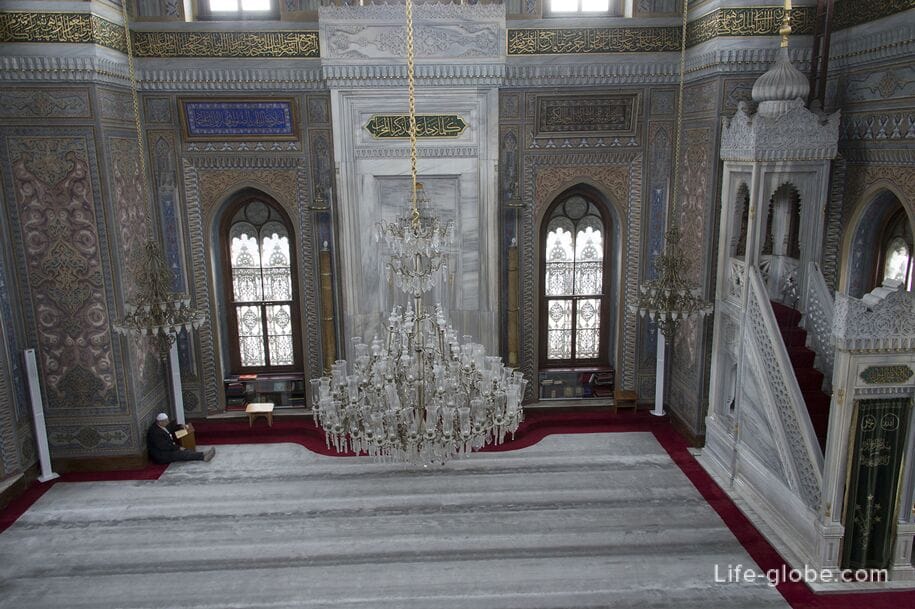
Pantokrator Monastery (Zeyrek Mosque)
The Pantokrator Monastery or Molla Zeyrek Mosque (Molla Zeyrek Camii) is the second largest monument of Byzantine architecture, preserved from Constantinople, after the Hagia Sophia Mosque.
The monastery is a complex that is known as the Monastery of Christ the Almighty (Christ Pantocrator, Pantokrator Manastırı), built since 1118 by the Byzantine Empress Irina Komnena.
During the history it was an Orthodox monastery, an imperial palace and a mosque.
Today, the complex is listed as a UNESCO World Heritage Site.
Near the mosque there is a panoramic cafe with a beautiful observation deck.
The complex is located on the European side of Istanbul, in the Fatih district, in the Zeyrek quarter, at the address: Zeyrek, Ibadethane Sk. No:2, 34083 Fatih/Istanbul, Turkey. Learn more about the Zeirek Mosque and the panoramic observation deck...
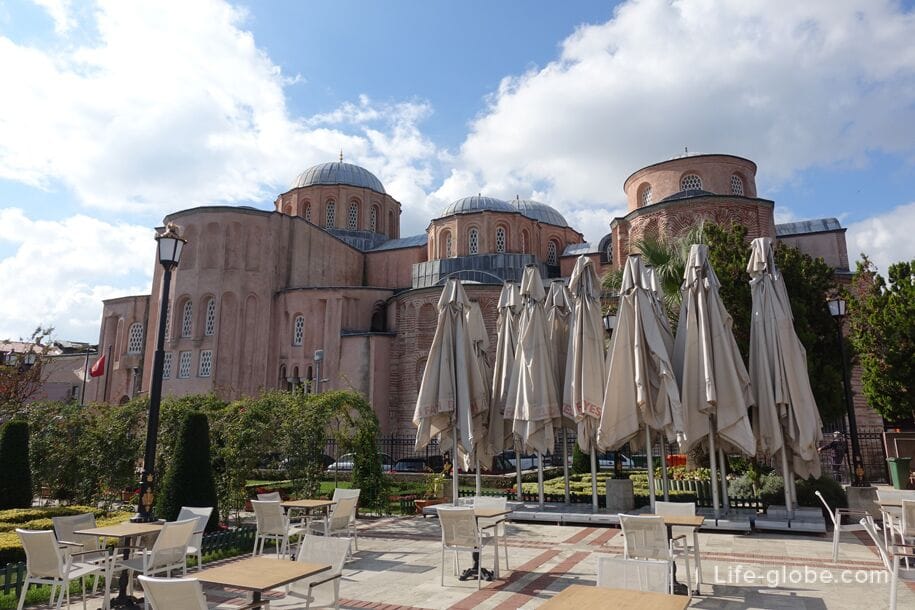
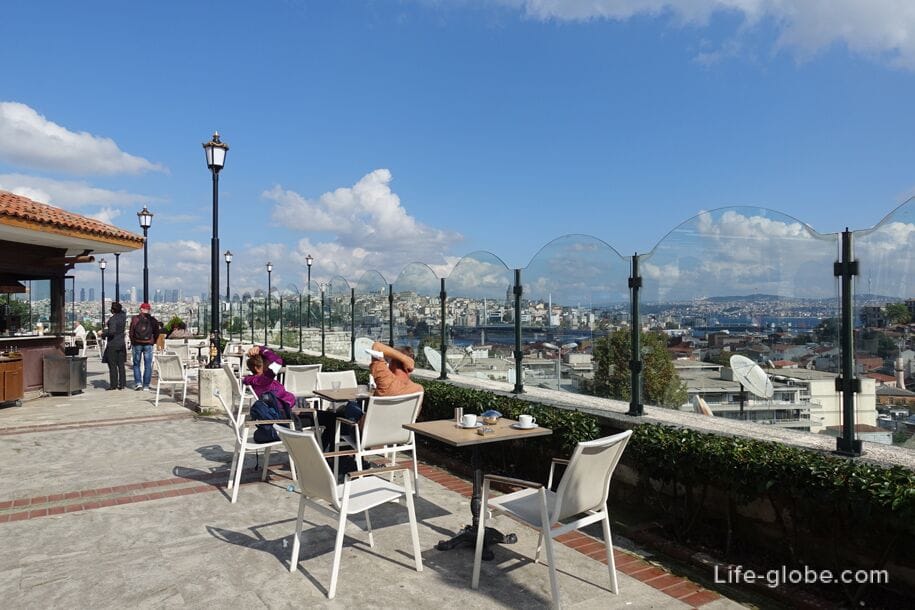
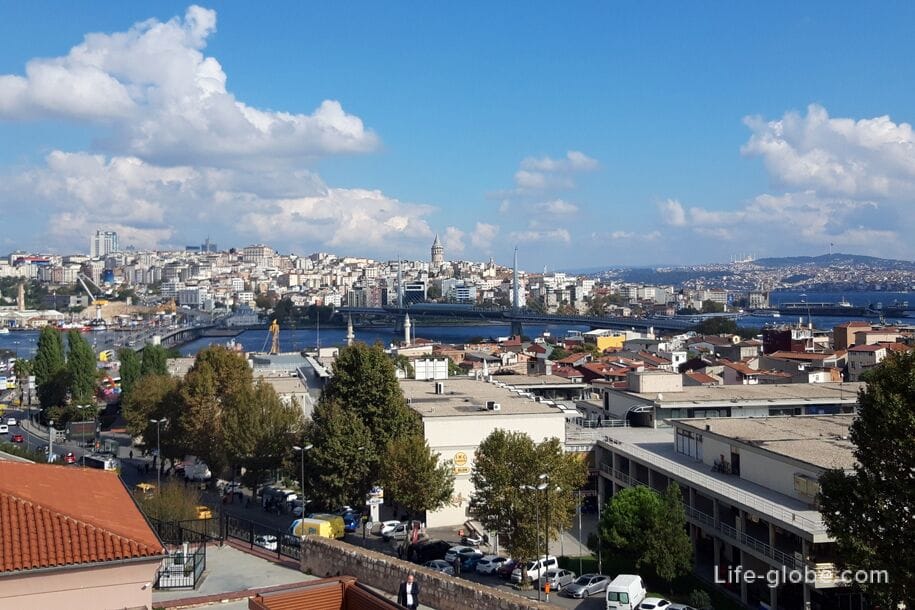
Fatih Mosque
Fatih Mosque (Fatih camii) was built as a complex on the hill of the city by order of Sultan Mehmed II the Conqueror in 1463-1470 on the site of the Byzantine Church of the Holy Apostles.
The mosque was destroyed by an earthquake in 1766 and rebuilt in 1771.
There is a madrasah at the mosque, and in the courtyard there is a cemetery where Mehmed II rests in the mausoleum, whose tomb is one of the important city shrines.
The mosque is located in the historical center of Istanbul.
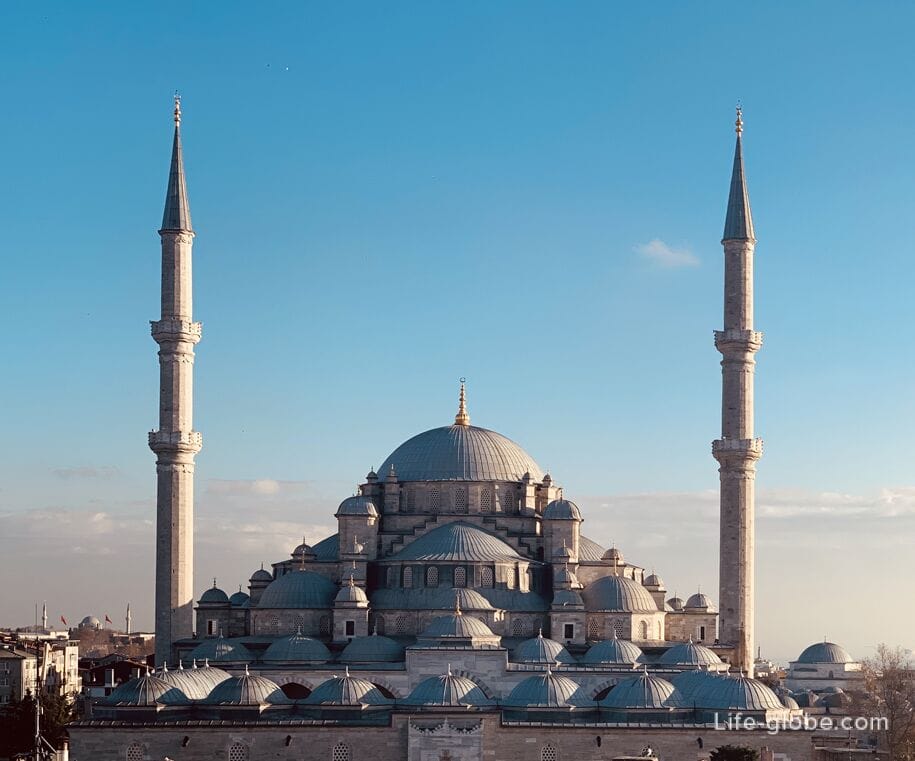

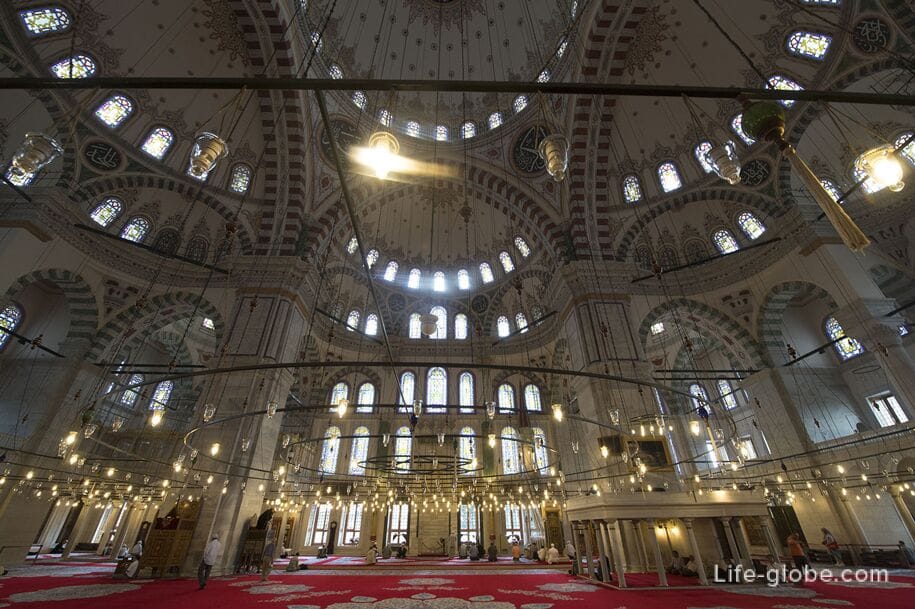
Selim Yavuz Mosque
The mosque of Selim Yavuz or Selim the Terrible (Yavuz Sultan Selim Camii) is an Ottoman imperial mosque of the 16th century with narrow minarets, a large dome, and a view of the Golden Horn Bay.
The mosque is also known as Selim I Mosque or Sultan Selim Yavuz Mosque, and is the second oldest surviving imperial mosque in Istanbul.
The mosque was completed in 1527-1528. The construction was commissioned by the Ottoman Sultan Suleiman the Magnificent in memory of his father Selim I, who died in 1520.
In the garden behind the mosque is the turbe of Sultan Selim I, built in 1523. The second octagonal turbe with a long inscription carved on the masonry outside contains the tombs of the four children of Suleiman the Magnificent and dates back to 1556. The third turbe belongs to Sultan Abdul-Majid I and was built shortly before his death in 1861.
The mosque's garden offers panoramic views of Istanbul and the Golden Horn Bay.
Address Mosques: Balat, Sultan Selim Cd. No.:18, 34087 Fatih/Istanbul, Turkey.
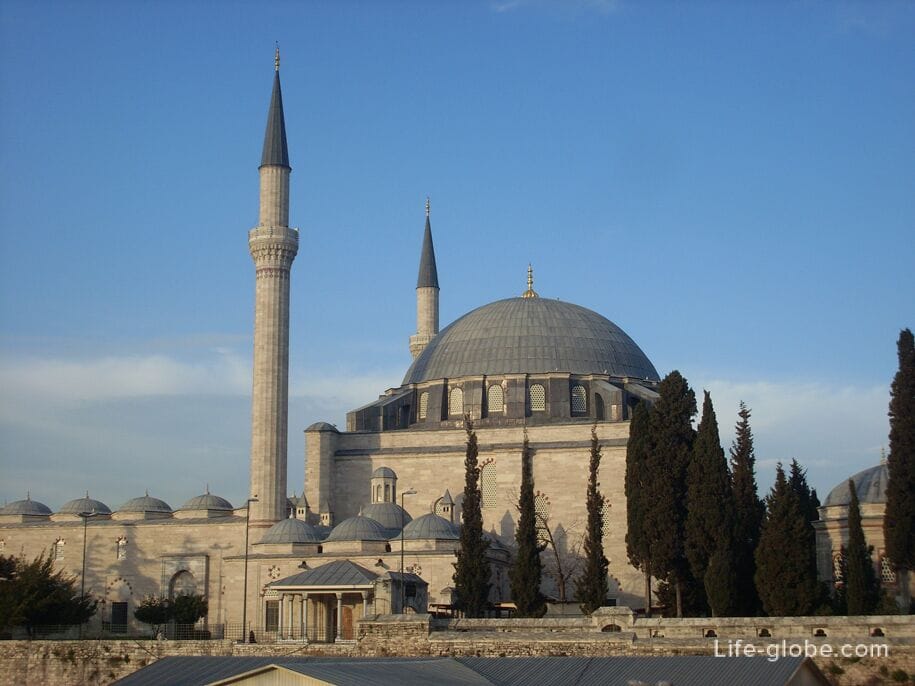

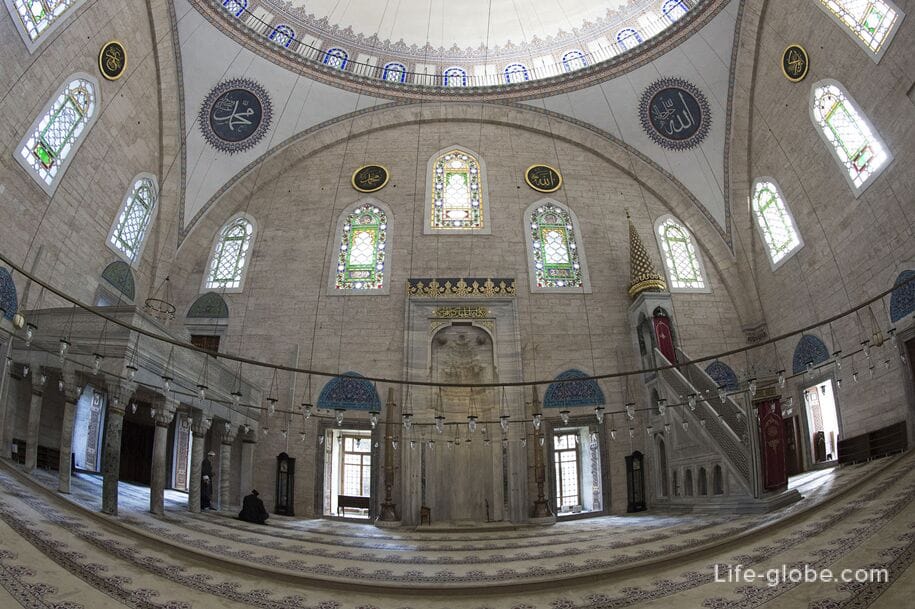
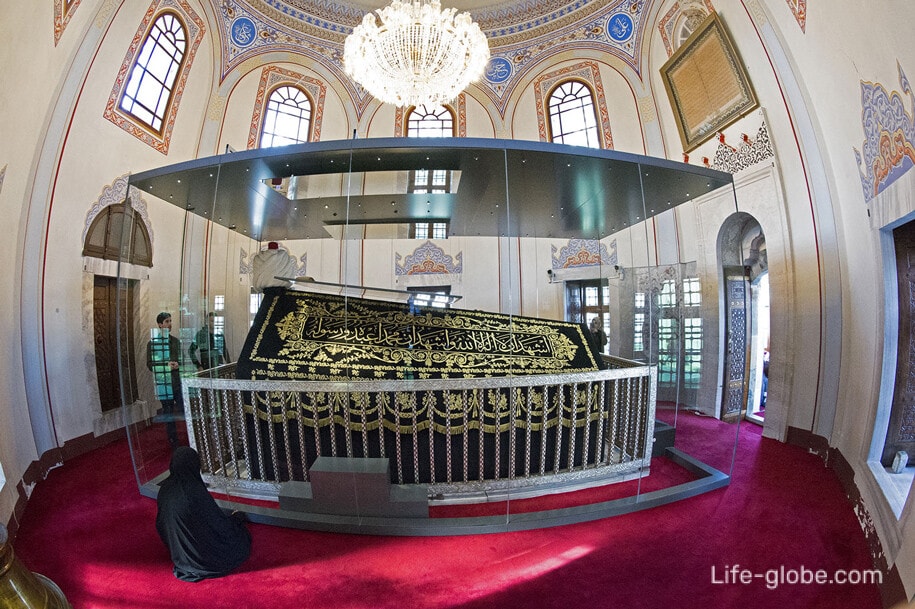
St. George 's Cathedral
St. George's Cathedral (Aya Yorgi Kilisesi) is the main Orthodox cathedral of Istanbul, which, since about 1600, has been the seat of the Ecumenical Patriarchate of Constantinople.
This church, dedicated to the Christian martyr St. George, is the venue for numerous important services.
During its history, the church has been rebuilt many times. It has a rich altar, an iconostasis, mosaics in the interior, relics of saints, ancient icons and part of the column "flagellation pillar" - the most important shrine-a pillar with the remains of the ring to which, according to legend, Jesus Christ was chained.
Church address: Yavuz Sultan Selim, Dr. Sadık Ahmet Cd. No:19, 34083 Fatih/Istanbul, Turkey.
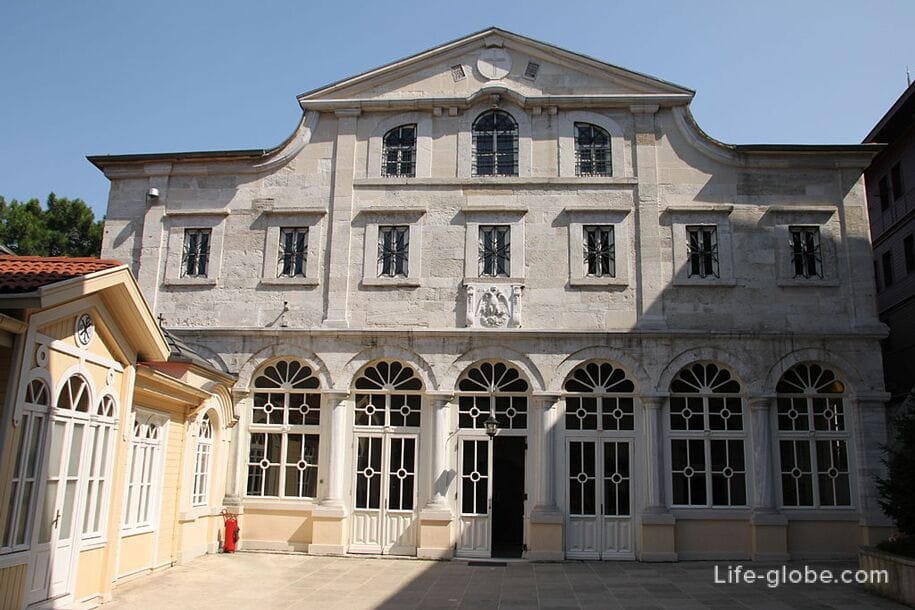
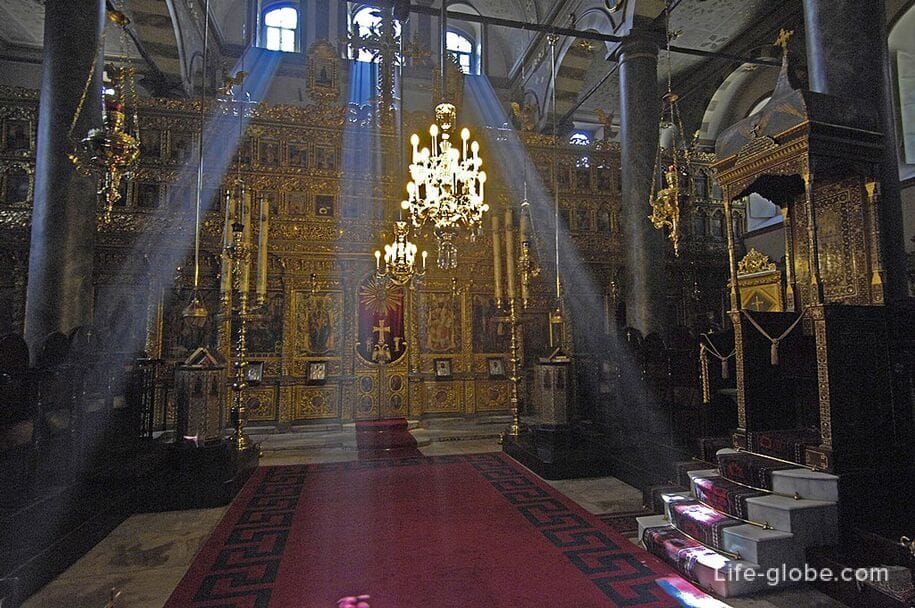
Church of Our Lady of Pammakarista (Fethiye Mosque)
The Church of the Theotokos of Pammakarista (Fethiye Camii, Mosque of Conquest) is a former Greek church of the Pammakaristos Monastery, turned into the Fethiye Mosque in 1591, with exquisite mosaics and late Byzantine architecture.
Most scholars believe that the church was built between the 11th and 12th centuries, while others attribute the original building to the 8th century.
The building serves as one of the most important examples of Palaiologan architecture of Constantinople and the last pre-Ottoman architectural monument. The shrine also has the largest number of Byzantine mosaics in Istanbul after Hagia Sophia and the Choir Church.
Church address: Balat, 34087 Fatih/Istanbul, Turkey.
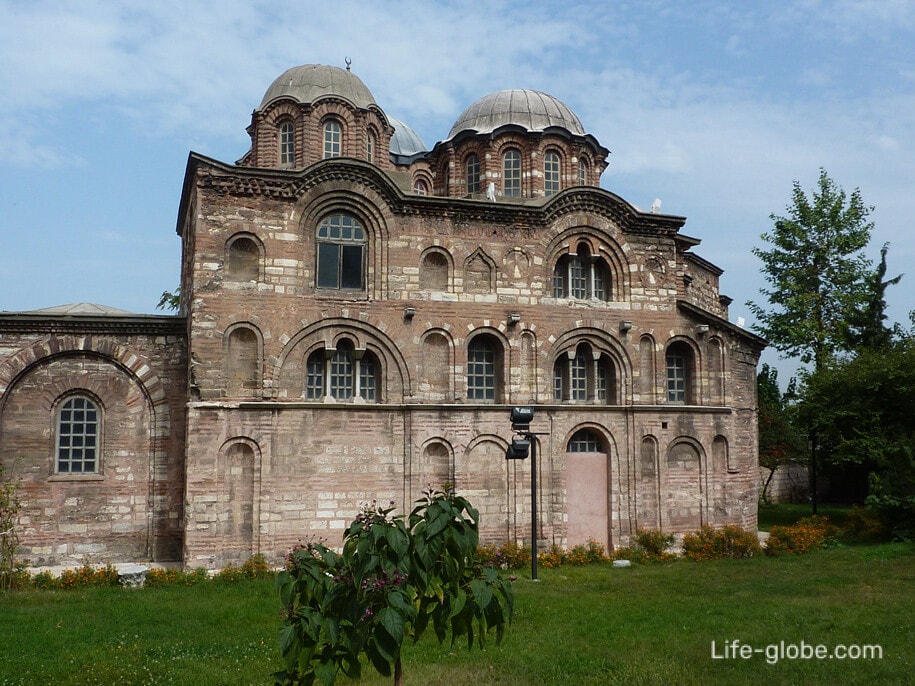
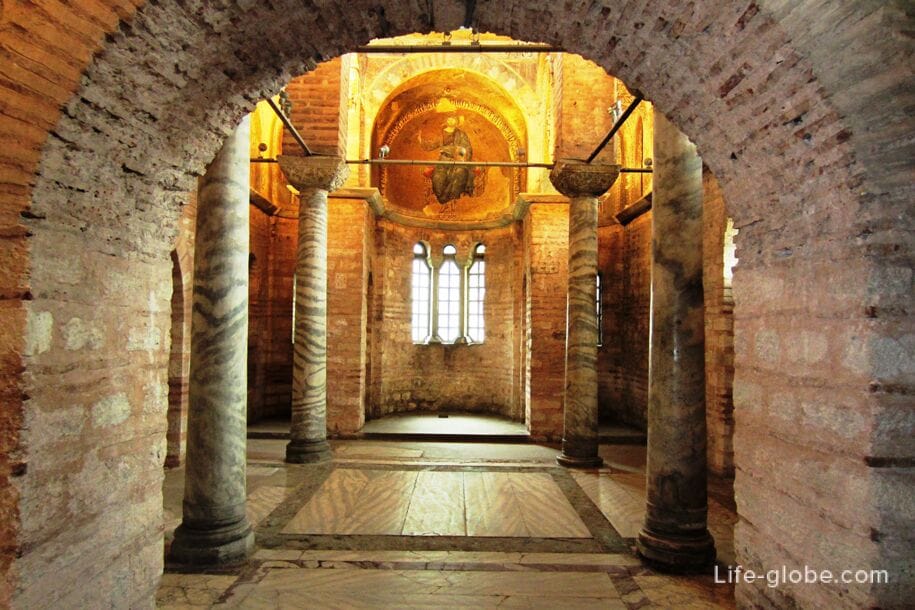
Khora Monastery (Kariye Mosque)
The Kariye Mosque or Monastery of Chora, also the Church of the Holy Savior in Chora (Kariye Camii) is a medieval Greek Orthodox church used today as a mosque.
The Church of the Savior in the Choir is built in the style of Byzantine architecture. In the 16th century, during the Ottoman Empire, the Christian church was turned into a mosque. It became a museum in 1945 and was turned into a mosque again in 2020.
The interior of the building is covered with some of the oldest and best preserved Byzantine Christian mosaics and frescoes. In addition to mosaics, the mosque also has colorful and patterned marble decorations.
After the building was converted from a church into a mosque, Christian symbols: inscriptions, frescoes and mosaics were covered with fine paint and lime whitewash, without destroying the building, so it has survived to this day.
Mosque address: Dervişali, Kariye Cami Sk. No:18, 34087 Fatih/Istanbul, Turkey.
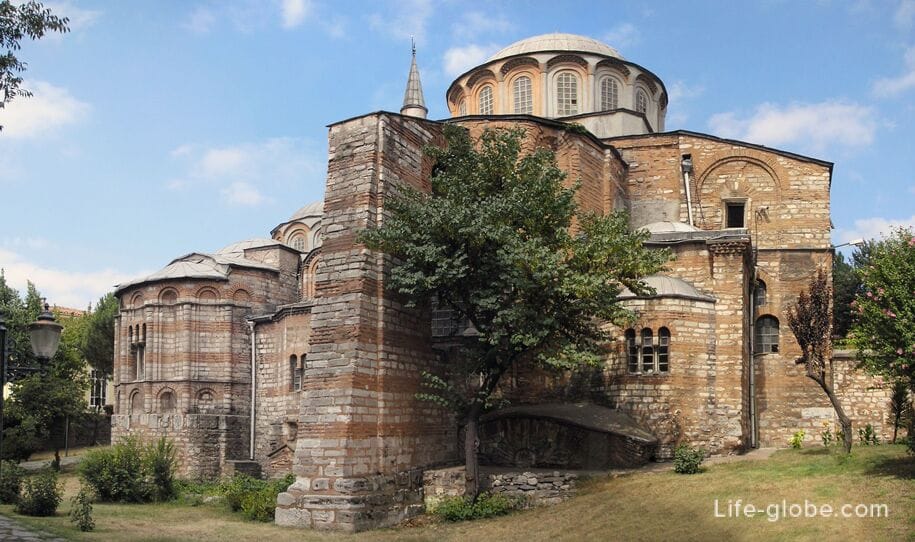

Eyup Sultan Mosque
The Eyup Sultan Mosque (Eyüp Sultan Camii) is a 15th-century mosque, rebuilt in 1800, and has features of the Baroque style.
The mosque was a traditional place for the coronation ceremony of the Ottoman sultans, where the new sultan was girded with the sword of Osman.
Sultan Eyup Mosque is now one of the oldest and most sacred mosques in Turkey. It is the fourth most important Muslim shrine in the world after Mecca, Medina and Jerusalem.
The mosque complex includes a mausoleum marking the place where Abu Ayyub al-Ansari, the standard-bearer and friend of the Islamic Prophet Muhammad, is said to have been buried.
Eyup Sultan is believed to have died during the first Arab siege of Constantinople in the 670s. His mausoleum-grave is very revered by Muslims and is located on the territory of this mosque.
The mosque is located near the lower station of the Eyüp-Piyer Loti Teleferik Hatt (TF2) gondola cable car, which lifts guests to the observation deck of Pierre Loti Hill, which offers stunning panoramic views of Istanbul. You can combine a visit to two attractions. More about the Pierre Loti observation and cable car...
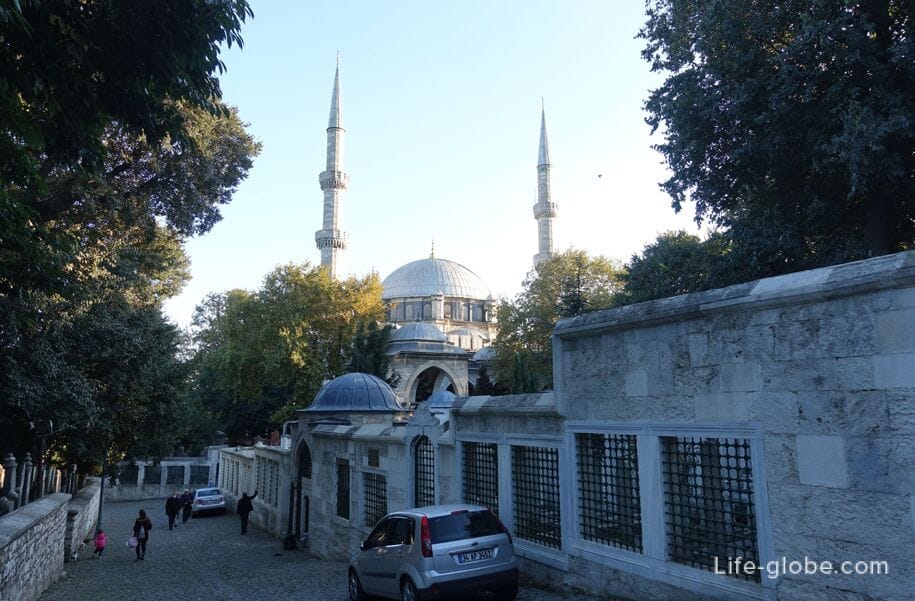
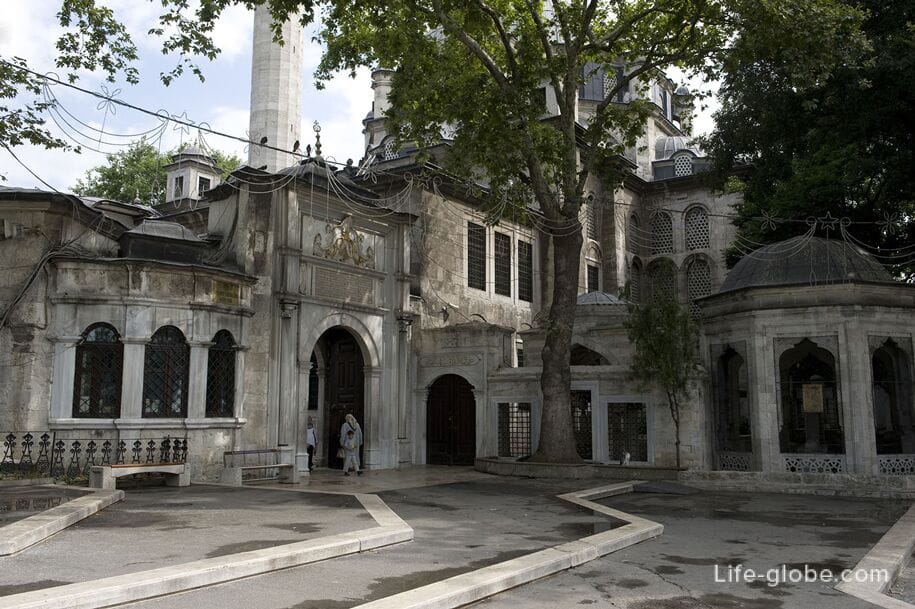
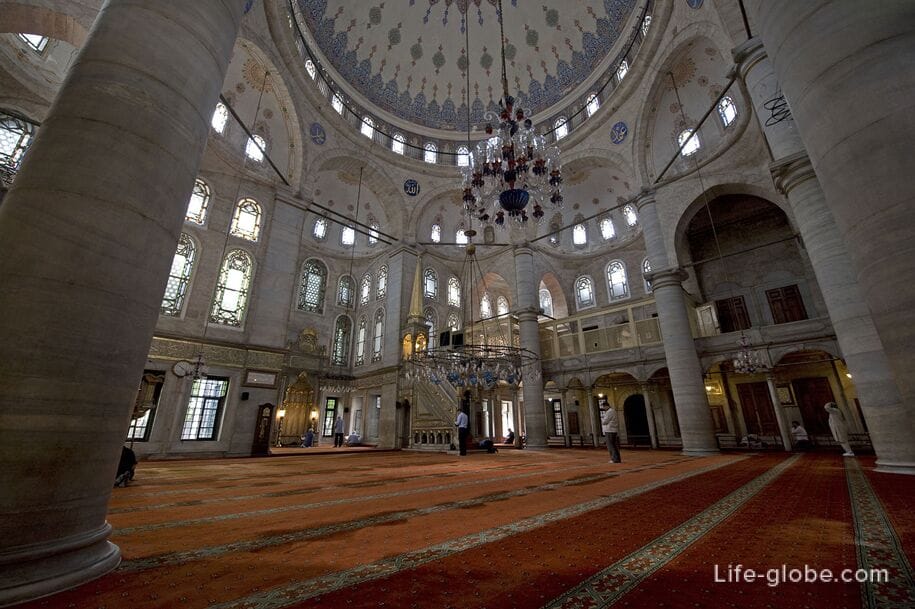
Photo of the Pierre Loti viewing room
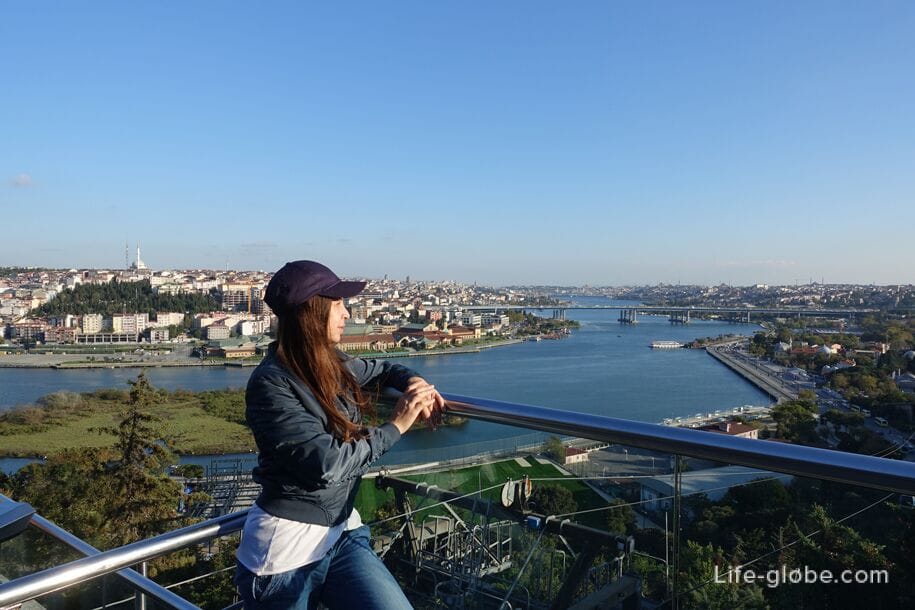
Holy Trinity Church
The Church of the Holy Trinity (Aya Triada Rum Ortodoks Kilisesi) is a Greek Orthodox church opened in 1880.
The temple stands out with stained glass windows, gilded domes and elegant paintings on the ceiling.
The church is located near Taksim Square (Taksim Meydanı), at the address: Katip Çelebi Mah., 34433 Beyoğlu/Beyoglu/Istanbul, Turkey. More about Taksim Square...
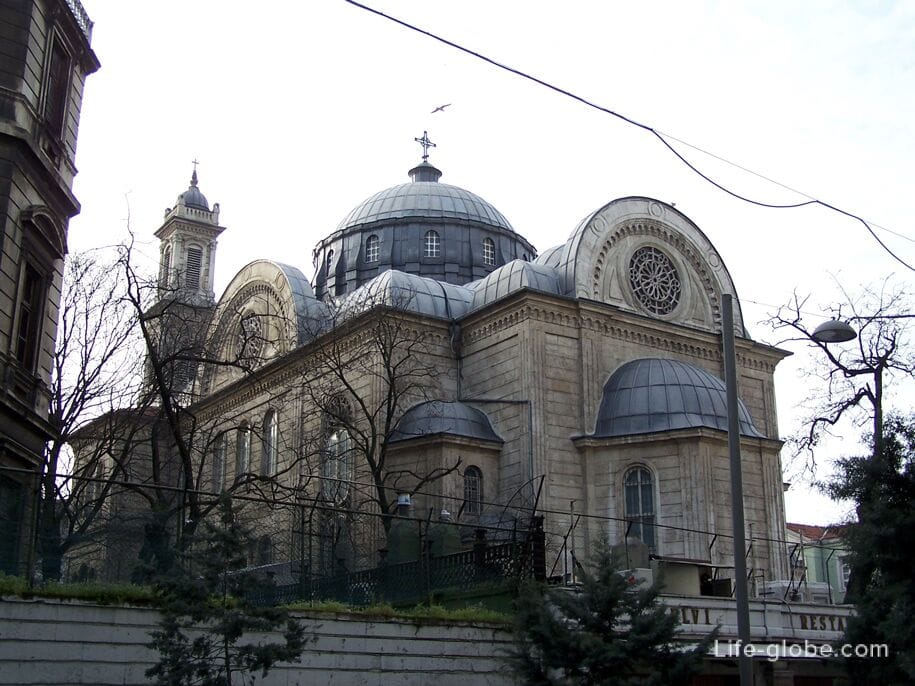
Yildiz Hamidiye Mosque
Yıldız Hamidiye Mosque (Yıldız Hamidiye camii) is an Ottoman imperial mosque built in 1884-1886 by order of the Ottoman Sultan Abdul Hamid II.
The architecture of the mosque is a combination of Neo-Gothic and classical Ottoman styles. The mosque has one minaret.
The mosque is located near a large historical palace and park complex of the 19th century - Yildiz (Yıldız). More about Yildiz Palace and Park...
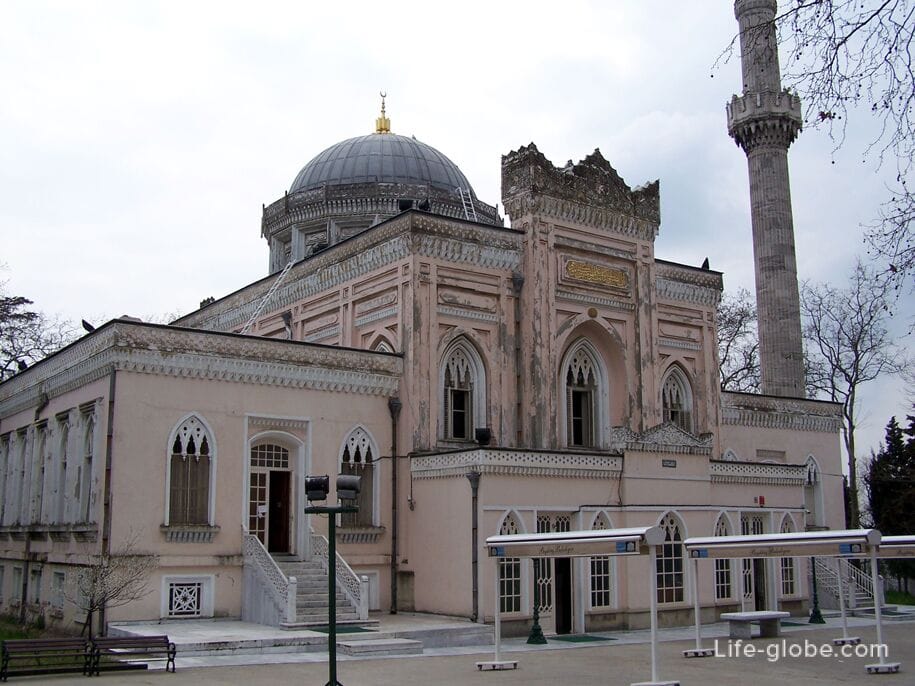
Ortakoy Mosque
The Ortakoy camii Mosque, also known as the Grand Mosque of the Medjidiye (Büyük Mecidiye Camii), is a very popular mosque in Istanbul and primarily due to the fact that it looks like a small sultan's palace and is located near the waters of the Bosphorus Strait, which makes the mosque one of the most photographed attractions in the city.
The mosque was built in the Ottoman Baroque style in 1853-1854 by decree of Sultan Abdul-Majid I.
The mosque has two minarets.
Mosque address: Mecidiye, Mecidiye Köprüsü Sk. No:1 D:1, 34347 Beşiktaş/Istanbul, Turkey.
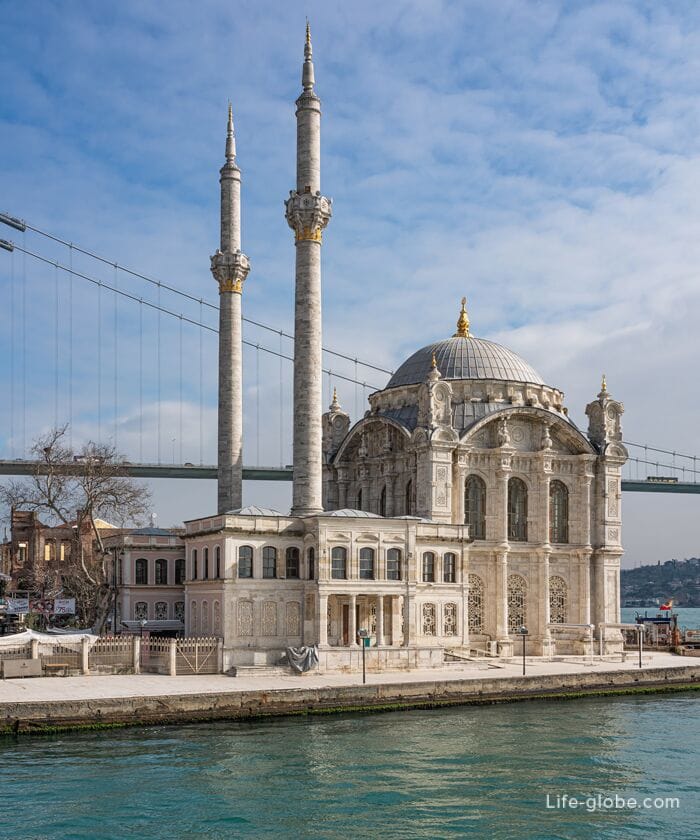
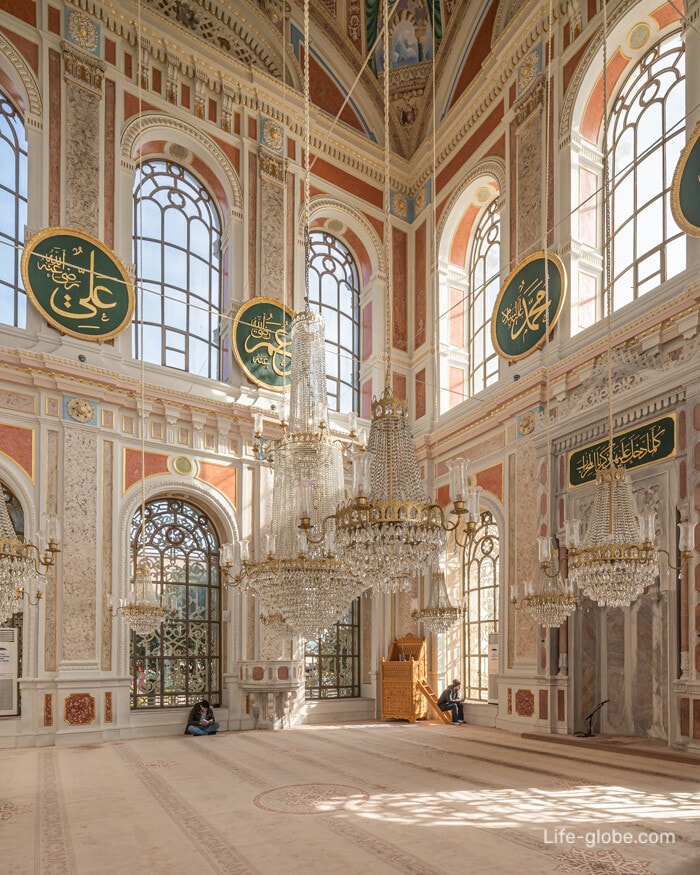
Beylerbey Mosque
Beylerbey Mosque or Hamid-i-Evvel Mosque (Beylerbeyi camii, Hamid-i Evvel Camii) is an 18th-century sultan mosque, which is one of the most impressive mosques on the Asian side of Istanbul and is considered one of the most beautiful manor mosques in Istanbul.
The mosque building was built by Sultan Abdulhamid I in memory of his mother Rabia Sermi Sultan, in the place where part of the former Beylerbeyi Palace was located. The mosque opened its doors for worship on August 15, 1778.
Since the mosque is located near the waters of the Bosphorus and suffered from constant water flows, it was changed during the reign of Mahmut II.
The mosque is located near the former Sultan's Palace of Beylerbeyi (Beylerbeyi Sarayı), at the address: Beylerbeyi, 34676 Üsküdar/Istanbul, Turkey. More about the Beylerbeyi Palace...
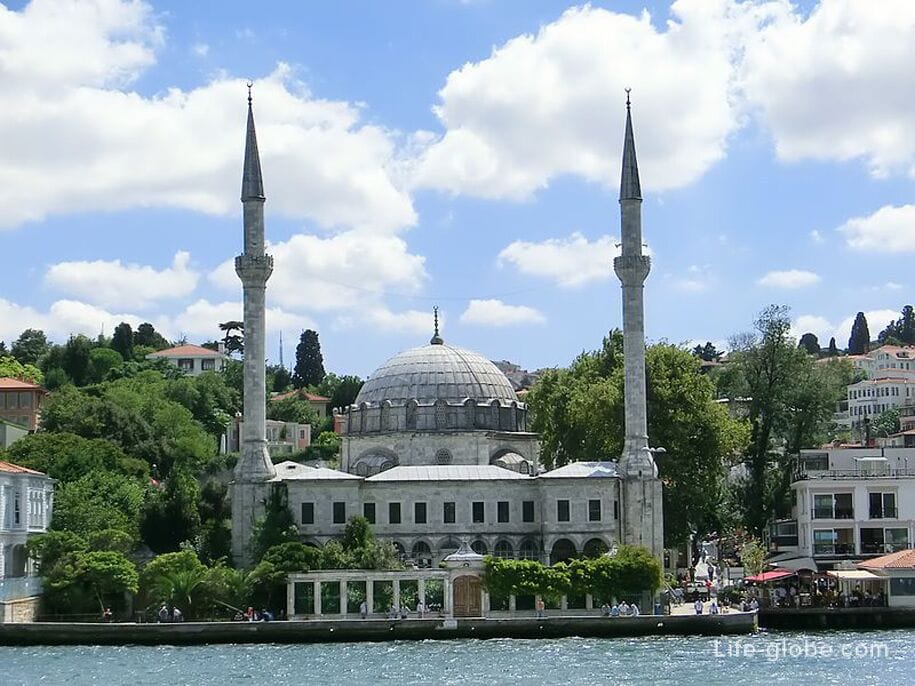
Chamlyja Mosque
The Chalmidja Mosque (Büyük Çamlıca camii) is the largest mosque in Istanbul, which is new, its construction was completed in 2019.
This mosque has six minarets, which represent the six symbols of the Islamic faith.
The Chamlija Mosque has a museum, underground parking, an art gallery, a library, a conference hall and a kindergarten.
Among the guests of the city, the Chalmidzha Mosque is also attractive because it is located on the Large Hill of Chamlidzha (Çamlıca Tepesi), where beautiful panoramic views of Istanbul open from the terrace near the mosque. And in a public park on a hill with trees, flower beds and fountains there are historical tea houses, cafes and a restaurant.
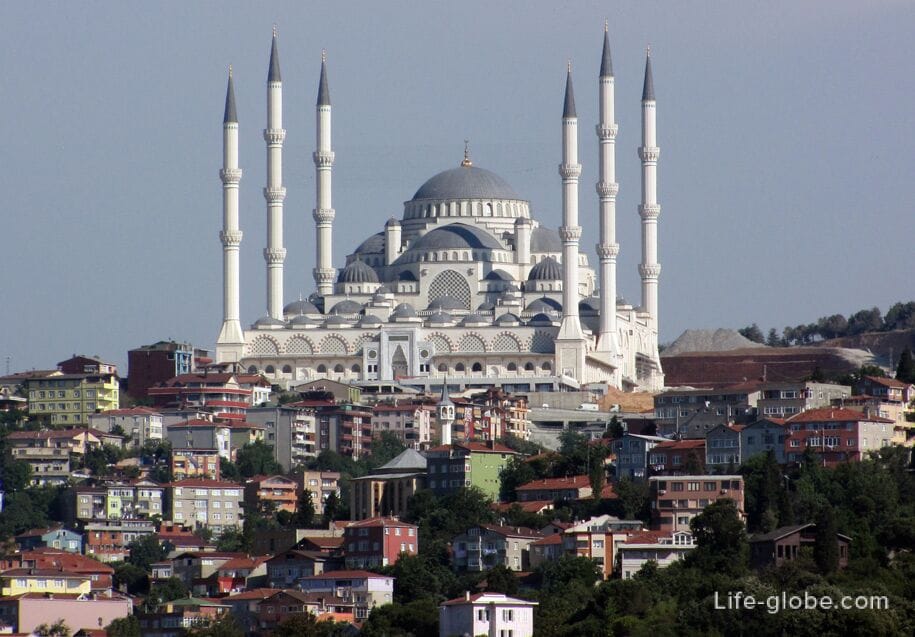
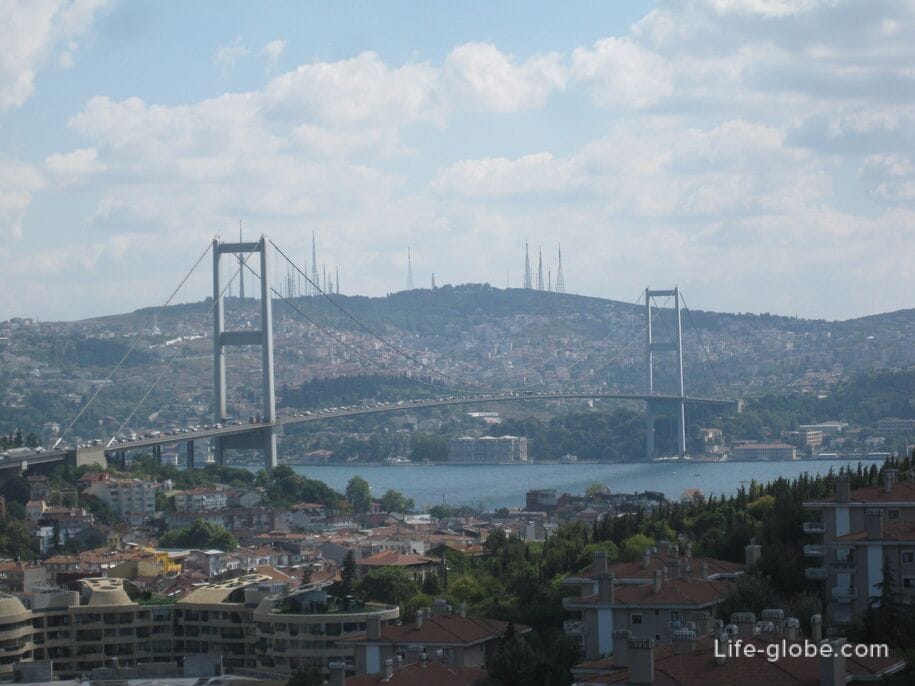
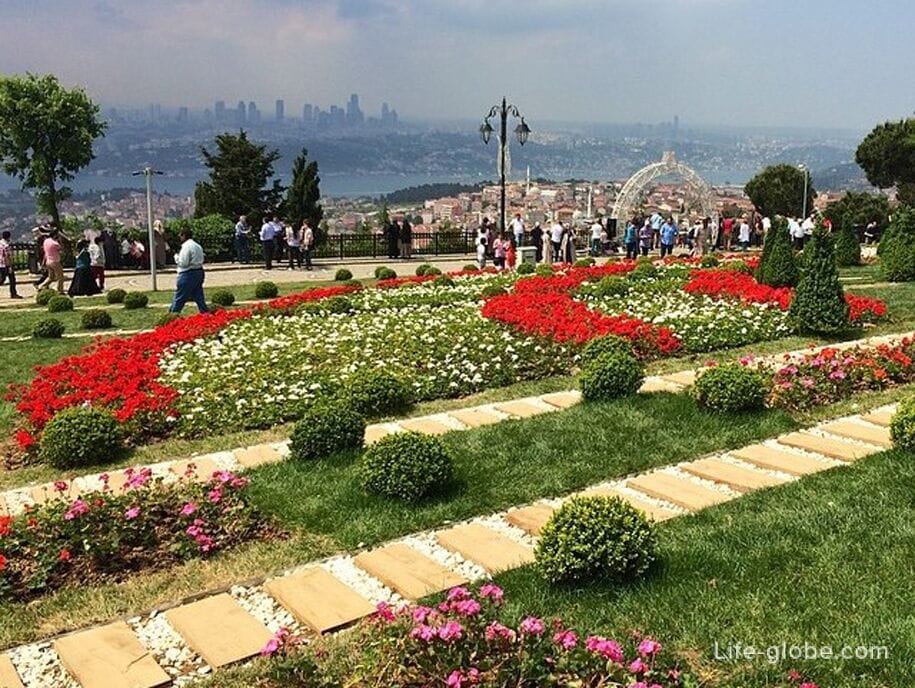
Shemsi Ahmed Pasha Mosque
The mosque of Shemsi Ahmed Pasha (Şemsi Ahmed Paşa Camii) is another masterpiece of Istanbul, which, like the Ortakoy Mosque, is located near the waters of the Bosphorus and is very photographed.
They say that birds never land on this mosque, and this is due to the fact that the architect of the mosque, Sinan, designed it so that the roof of the mosque was exactly at the intersection of the winds, which birds are not able to cope with.
The mosque was built in 1580 at the expense of the ruler of Anatolia and Rumelia - Shemsi Ahmed Pasha.
The mausoleum of Shemsi Ahmed Pasha adjoins the mosque. The mosque complex also includes a madrasah, a cemetery and an inner courtyard. A minaret is attached to the southwest corner of the prayer hall.
The mosque is located on the Asian side of Istanbul, in the Usküdar district, not far from the famous Maiden Tower (Kız Kulesi).
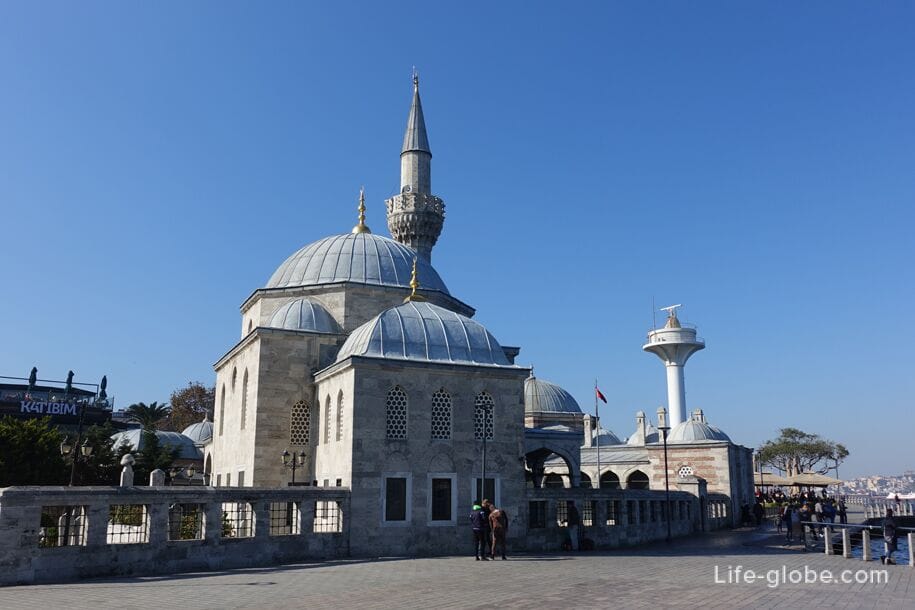
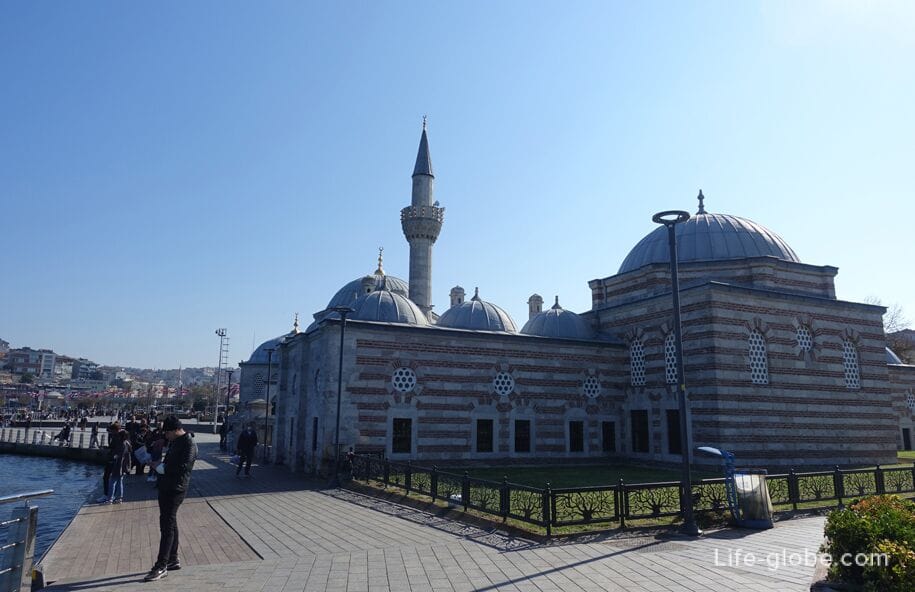
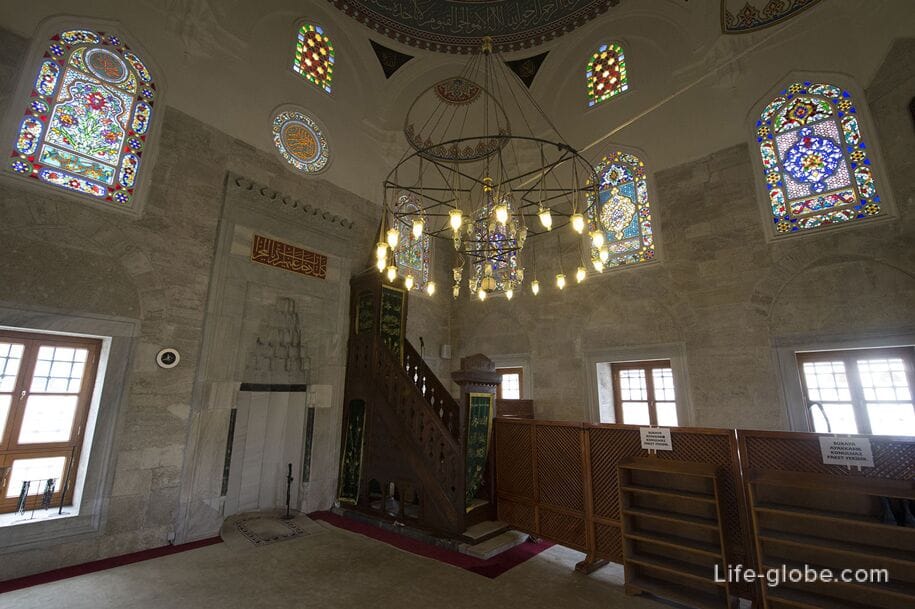
Practical information
Before visiting a particular shrine in Istanbul, we recommend checking its opening hours and visiting conditions.
Tourists are not allowed to visit mosques during namaz.
When visiting mosques, the knees and shoulders should be covered, and women's heads should be covered. In many mosques, you can take shawls and capes at the entrance.
Entrance to all mosques is free.
All accommodation facilities in Istanbul, including in the historical center, on the European and Asian sides of the city, can be viewed and booked here







